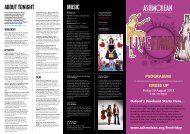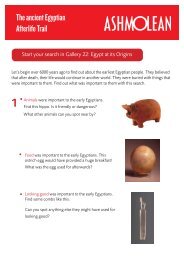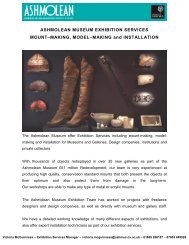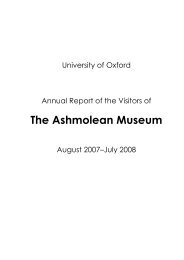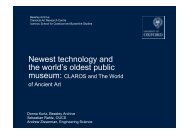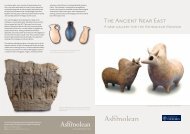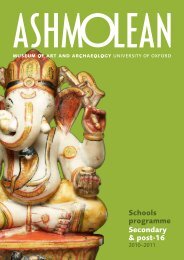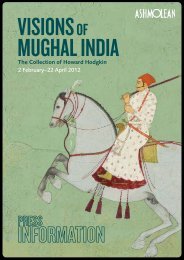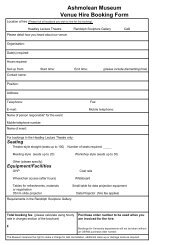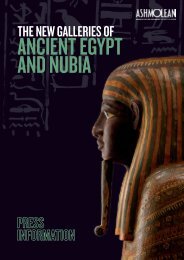A N N U A L R E P O R T - The Ashmolean Museum
A N N U A L R E P O R T - The Ashmolean Museum
A N N U A L R E P O R T - The Ashmolean Museum
You also want an ePaper? Increase the reach of your titles
YUMPU automatically turns print PDFs into web optimized ePapers that Google loves.
Focus on Research / 25<br />
Focus on Research<br />
All departments in the <strong>Museum</strong> perform research of international<br />
importance. <strong>The</strong> breadth of scholarship and subject matter is<br />
impressive. Each year we focus on a particular project as just one<br />
example.<br />
Historic British Archaeology Collections at the <strong>Ashmolean</strong> <strong>Museum</strong><br />
<strong>The</strong> Historic British Archaeological Collections Project is a two-year programme<br />
of work funded by the Arts and Humanities Research Council with the aim of<br />
enhancing both physical and intellectual access to these collections by the general<br />
public and by researchers alike. <strong>The</strong> Project is directed by Dr Arthur MacGregor,<br />
Senior Assistant Keeper in the Department of Antiquities, and managed by Alison<br />
Roberts, Antiquities Collections Manager. Project staff members are Christine<br />
Edbury (full-time), Angela Cox (half-time) and Jennifer Foster (half-time). An<br />
IT assistant will be appointed during the second year of the project. Further<br />
details will soon be available on the <strong>Ashmolean</strong> website.<br />
Robert Plot, Antiquarian and<br />
first Keeper of the <strong>Ashmolean</strong><br />
<strong>Museum</strong>.<br />
When the then Keeper, John Phillips, proposed in 1858 that the <strong>Ashmolean</strong><br />
be developed into a ‘<strong>Museum</strong> of National Antiquities’ he was responding<br />
both to a growing awareness of the importance of indigenous antiquities in<br />
Britain, and elsewhere in Northern Europe (as opposed to the interest in<br />
classical antiquities which arose during the European Renaissance), and to the<br />
long history of the <strong>Ashmolean</strong> in promoting the study of such material.<br />
From the start, the <strong>Ashmolean</strong> had been associated with British antiquarian<br />
interests through the first two Keepers, Robert Plot and Edward Lhwyd, both<br />
of them pioneers in the field. Later it attracted benefactions from other early<br />
investigators such as William Borlase, and the first donation of a<br />
systematically excavated body of material – that recovered by the Revd James<br />
Douglas in Kent in the 1770s. Indeed, for much of its early existence the<br />
<strong>Ashmolean</strong> provided a focus for antiquarian and archaeological work in<br />
Britain. It was also for a long time one of the few repositories (if not the only<br />
one) available for such material, with the result that archaeological material<br />
from all over the country found its way into the collection. Probably the best<br />
known example of such finds is the ‘Alfred Jewel’, found in 1693 at North<br />
Petherton in Somerset and presented to the <strong>Museum</strong> in 1718.<br />
<strong>The</strong> Alfred Jewel and the record<br />
of its presentation to the<br />
<strong>Museum</strong> in 1718.<br />
During the later Victorian era the <strong>Ashmolean</strong> became a focus for the<br />
developing profession of archaeology, both in Britain and abroad. In<br />
particular, the Keepership of Sir Arthur Evans did much to establish its<br />
reputation as an archaeological museum of national and international<br />
importance. Following Evans, responsibility for collecting British material fell<br />
largely to Edward Thurlow Leeds, who joined the <strong>Museum</strong> in 1908 and<br />
remained a leading figure in medieval archaeology and the archaeology of the<br />
Thames Valley until his death in 1955. As well as his original research, Leeds<br />
also encouraged the development of innovative archaeological techniques,<br />
including the use of aerial photography (with G Allen) and geophysical




